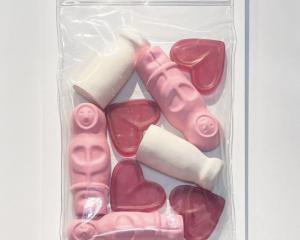"At the museum/Cry of the young karearea", by Ray Ching (Milford Gallery).
The works form a well-matched and cohesive whole. Several of the pieces will be familiar to visitors to the Milford, though others are new to the gallery.
Among the former are the sinister pastoral landscapes of Marc Blake and gloriously whimsical anthropomorphic animals of Joanna Braithwaite, both of which bear repeated viewing.
Gary Waldrom's skewed southern townscapes, with their otherworldly carnival figures are also a welcome return. Two artists not as frequently seen in Dunedin figure prominently. Paul Martinson's works are spectacular in detail and impressive in scope.
In watercolour and gouache paintings like Wedding Safari, the soft delicacy of line is matched perfectly to the halcyon yet unsettling subject matter. In contrast, his oils capture the vividness and colour of their surreal subject matter.
Ray Ching's images are a strong addition to the exhibition. Best known for his bird studies, here he presents a series of allegorical pieces, some illustrating modern reinterpretations of Aesop's fables and others delicately presenting flights of birds, people, and animals across a background of comic-book panels.
"Tip" by Mike Armstrong (Monumental Gallery)
Several characters and figures repeat in the images, most frequently the "technological being", a skull-like visage looming over a wooden stool.
This skull, actually a jet engine, is simply an updated version of Duchamp's ready-made sculpture of a similarly mounted bicycle wheel.
Other recurring forms include a distorted taniwha-like creature and an "alien rabbit". The works are busy, and the incomplete, heavy brushwork adds to their sombre and somewhat sinister feel.
Whereas the majority of the large works rely on their painterliness, they are at their most effective in their more delicately drawn background features - stepladders, chairs, and pipes. The simpler, cartoon-like smaller works work well, and are perhaps the more impressive pieces.
Here, in images such as the close-up portraits of the technological being and rabbit, the stripping back of subject matter makes the images more immediate.
"The Loss Adjuster" by Scott Flanagan (Blue Oyster Gallery)
On 22 February 2011, Flanagan was in his Lichfield St studio when it collapsed around him, taking his belongings with it.
The trauma of this event left a gap in the artist's memories, leading to feelings of slight disjunction from reality. For the artist, this seemed similar to the impersonality of official checkpoints, where a surveillance camera and a form are more important as personal validation than physical existence.
Flanagan's exhibition makes use of spools of videotape, the unwinding strips symbolising memory trace. They lie in profuse heaps or form a blank wall of plastic, an impassable gateway to the past.
The major installation, inspired by surrealist Marcel Duchamp, is a generic hotel-like room in which two refugees from a transit space - the two handrails which normally sit at the gallery's entrance - are locked in a cold embrace.
Woven videotape lattices form a dark well of memory upon the floor and lie behind the bed as a glistening black wall.
The shimmering reflections of ourselves in these sheets beckon us into a looking-glass world which may be fantasy, or may be the reality of which our own world is the distorted reflection.
- James Dignan








![Untitled (c. mid 1990s, [pink 3]), by Martin Thompson, 415mm×590mm. Photo: courtesy of Brett...](https://www.odt.co.nz/sites/default/files/styles/odt_landscape_small_related_stories/public/story/2024/02/untitled_pink_3.jpg?itok=Q0aQrc9o)



